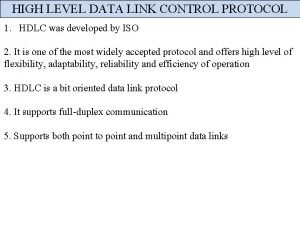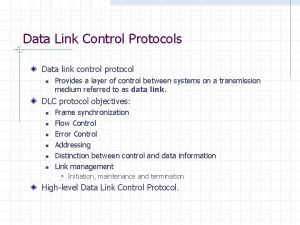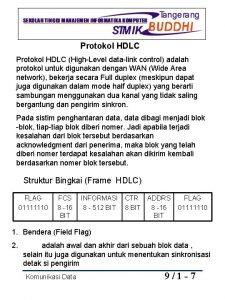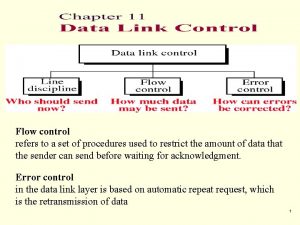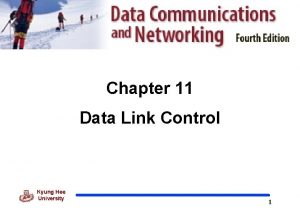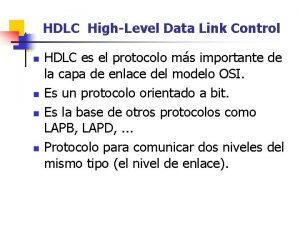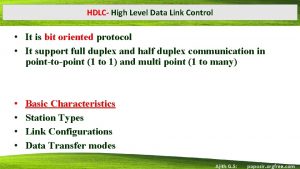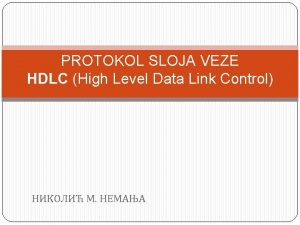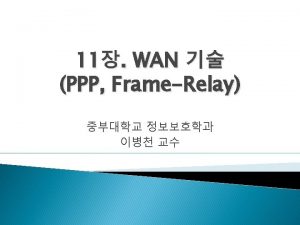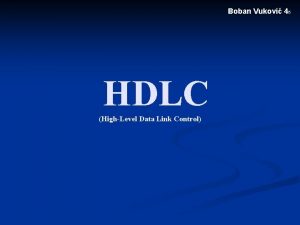HIGH LEVEL DATA LINK CONTROL PROTOCOL 1 HDLC












- Slides: 12

HIGH LEVEL DATA LINK CONTROL PROTOCOL 1. HDLC was developed by ISO 2. It is one of the most widely accepted protocol and offers high level of flexibility, adaptability, reliability and efficiency of operation 3. HDLC is a bit oriented data link protocol 4. It supports full-duplex communication 5. Supports both point to point and multipoint data links

HDLC OVERVIEW Defines three types of stations –Primary – Secondary – Combined • Defines three types of data transfer mode – Normal Response mode – Asynchronous Balanced mode • Three types of frames – Unnumbered – information – Supervisory

HDLC STATION TYPES The three stations are : – Primary station • Has the responsibility of controlling the operation of data flow the link. • Handles error recovery • Frames issued by the primary station are called commands. – Secondary station • Operates under the control of the primary station. • Frames issued by a secondary station are called responses. • The primary station maintains a separate logical link with each secondary station. – Combined station • Acts as both as primary and secondary station. • Does not rely on other for sending data

OPERATING MODES FOR DATA TRANSFER The three modes of data transfer operations are – Normal Response Mode (NRM) • Mainly used in terminal-mainframe networks. In this case, • Secondaries (terminals) can only transmit when specifically instructed by the primary station in response to a polling • Unbalanced configuration, good for multi-point links – Asynchronous Response Mode (ARM) • Mostly used for communication between primary and secondary stations • In ARM the secondary can transmit response (frame) without taking permission from the primary station • Transmission proceeds when channel is detected idle , used mostly in point-to-point-links

OPERATING MODES FOR DATA TRANSFER – Asynchronous Balanced Mode (ABM) • Mainly used in point-to-point links, for communication between combined stations • As both these stations are combined stations, They are capable of link management functions • As the communication is asynchronous, one station can transmit a frame without permission from the other station.

FRAME STRUCTURE OF HDLC

Address Field: The address field consists of the address of the secondary station irrespective of whether a frame is being transmitted by primary or secondary station. Address field consists of 8 bits and hence it is capable of addressing 256 addresses Information field: The field size of information field is variable and it can consists of any number of bits. It consists of users data bits and is completely transparent. Frame Check Sequence (FCS) Field: This is a 16 bit field used for detection of errors in the address, control and information field. It is nothing but the 16 bit CRC for error detection Control bits…. . Hold on please

FRAME TYPES OF HDLC 1. HDLC uses the control field (C) to determine how to control the communications process. 2. There are three types of frames defined in HDLC – a. The I-Frame or information frame b. The S-Frame or the supervisory frame c. The U-Frame or the unnumbered frame

I-FRAME OF HDLC 1. If the first bit in the control field is 0, it is identified as an information frame (I-Frame) 2. The next 3 bits (2 -4) are called N(S) and they are used to define the sequence number of the frame 3. Since there are only three bits we can define a sequence number between 0 and 7 only 4. The 5 th bit position in the control field is called the poll/final bit, or P/F bit. It can only be recognized when it is set to 1. If it is set to 0, it is ignored. The poll/final bit is used to provide dialogue between the primary station and secondary station. The primary station uses P=1 to acquire a status response from the secondary station. The secondary station responds to the P bit by transmitting a data or status frame to the primary station with the P/F bit set to F=1 5. The last 3 - bits define the value of ACK

S-FRAME OF HDLC 1. An S-frame does not contain any information field. These frames are used for flow and error control. 2. A 10 in the first two bits of the control field identifies it as a supervisory frame. 3. There are 4 types of supervisory frames corresponding to four possible values of the S bits in the control field 4. SS=00: corresponds to receive ready (RR) frames which are used to acknowledge frames when no I frames are available to piggyback the acknowledgement 5. SS=01: Corresponds to reject (REJ) frames which are used by the receiver to send a NAK when error has occurred. 6. SS=10: Corresponds to a Receive Not Ready (NRN) and it is used for flow control 7. SS=11: Corresponds to a Selective Repeat Frame which indicates to the transmitter that it should retransmit the frame indicated in the N(R) subfield

U-FRAME OF HDLC 1. These frames are used for exchanging the session management and control information between the communicating devices. 2. The 11 in the first two bits of the control field identifies an unnumbered frame 3. The information field is used for carrying the system management information. It does not carry the user data. 4. The U-Frame code bits are divided into two sections two bits before P/F and 3 bits after The unnumbered frame types are used for functions like initialization, status reporting and resetting 5. The I-Frame and S-Frame implement the error and flow control functions of the data link layer

IMPORTANT UNIVERSITY QUESTIONS OF DATA LINK LAYER 1. All mathematical examples done in class 2. Describe any five functions of data link layer (10 marks) 3. Write an example to explain different types of framing methods. (10 marks) 4. Explain CRC and Checksum (10 marks) 5. What is CRC ? Write an algorithm to calculate CRC and checksum (10 marks) 6. What are different data link layer protocols. Explain in Detail (10 marks) 7. Explain stop and wait and sliding window protocol (10 marks) 8. Why do we need sliding window protocol (5 marks) 9. Explain the factors that will determine the length of sliding window (5 marks) 10. Explain one bit sliding window protocol (5 marks) 11. Which protocol Go-back-N or Selective Repeat makes more efficient use of network bandwidth (10 marks) 12. Differentiate between Go back and Selective Repeat (10 marks) 13. Explain HDLC (10 marks)
